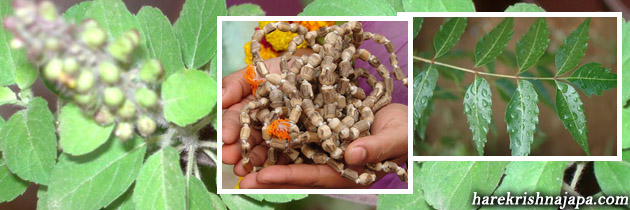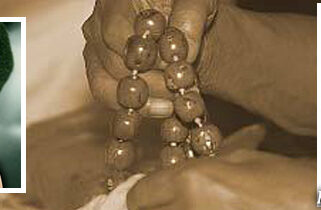On which beads should one chant Japa?

Tulasi beads are considered the topmost for japa mala, but other beads may also be used. After Tulasi, Neem beads are generally considered the best. Most any kind of wooden beads will do. Rudraksa beads, however, are not generally used by Gaudiya Vaisnavas, as they are symbolic of a different spiritual practice.
Ideally, one should cultivate and offer worship to Srimate Tulasi-devi. When Her plant form dies a natural death, you may then make beads out of Her branches. While the bead making process is somewhat tedious (drilling, not splitting, polishing, etc.), it is preferable to buying beads commercially. Even when you buy Tulasi beads from shops in Vrindaban, you can't necessarily be certain that Tulasi-devi was properly respected in the process. You might also make arrangements to get branches of a departed Tulasi from a temple (particularly those located in tropical climes, where Tulasi grows abundantly).
When you get a new set of Tulasi or neem beads, soak them in oil for a day or so before you start using them, so they don't crack and break with use. It's best to use Sandlewood oil, or mustard oil. If neither are available, you can use any vegetable oil (but not petroleum-based oils). Avoid using ghee, because it has a tendency to turn rancid with heat.
If stringing your own beads onto a cotton string, be sure to use a heavy gauge cotton, or one reinforced with nylon, so your beads don't break from daily wear and tear. Tie your beads in such a way as they don't get tangled up all the time in your bead bag. If there's too much string between the beads, they can become very tangled, and it's frustrating to have your japa interrupted by having to sort the tangle out.
It's become a bit of a trend for people to buy increasingly large strands of japa beads. Some devotees discourage this practice out of concern that it encourages the harvesting of live Tulasi plants for commercial purposes.
You may also wish to have two sets of japa beads: a small set that you can carry during the day, and a bigger set for home/temple use, which you may find it easier to concentrate on. It's always nice to have beads that are tapered, because the tapering sizes helps keep your mind on the progression of the round. Ideally, your Tulasi beads should be made from a single Tulasi plant, and in that case the bead size will naturally taper, as stalk and branches of various diameters are used in the making.





